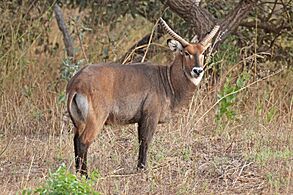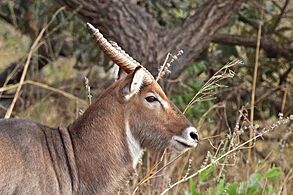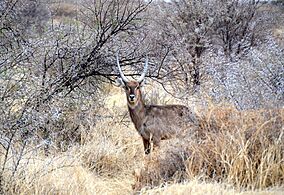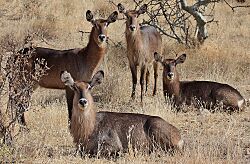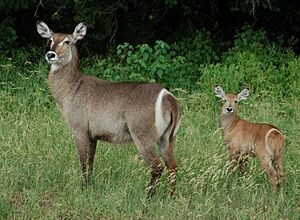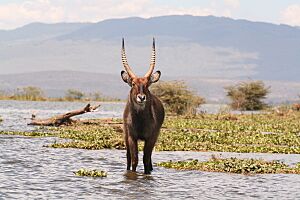Waterbuck facts for kids
Quick facts for kids Waterbuck |
|
|---|---|
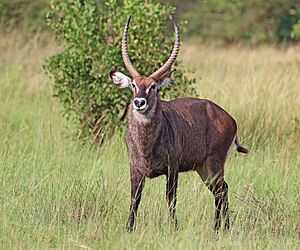 |
|
| Male K. e. defassa Queen Elizabeth National Park, Uganda |
|
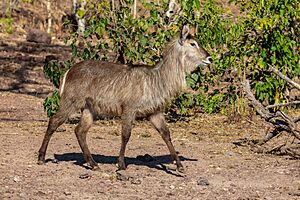 |
|
| Female K. e. ellipsiprymnus Chobe National Park, Botswana |
|
| Conservation status | |
| Scientific classification | |
| Subspecies | |
|
See text |
|
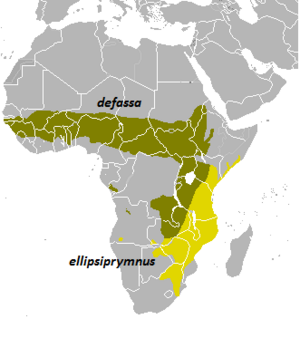 |
|
| Distribution of subspecies of waterbuck |
The waterbuck (Kobus ellipsiprymnus) is a large antelope that lives in sub-Saharan Africa. It belongs to the Kobus group within the Bovidae family. An Irish scientist named William Ogilby first described it in 1833.
Waterbucks are quite big. Their body length is usually between 177 and 235 centimeters (about 5.8 to 7.7 feet). They stand between 120 and 136 centimeters (about 3.9 to 4.5 feet) tall. Male waterbucks are taller and heavier than females. Males can weigh from 198 to 262 kilograms (about 437 to 578 pounds). Females weigh from 161 to 214 kilograms (about 355 to 472 pounds). Their fur can be brown or grey. Only males have long, spiral horns, which curve backward then forward. These horns can be 55 to 99 centimeters (about 21 to 39 inches) long.
Waterbucks like to stay in one place. They live in groups of six to 30 animals. These groups are either female herds with their young or male-only herds. Males start defending their areas around age five. Waterbucks need to stay near water because they can't handle hot, dry weather. They mostly eat grass and live in grasslands. In warm areas, they can have babies all year. But most births happen during the rainy season. A baby waterbuck is born after seven to eight months.
Waterbucks live in scrub and savanna areas near rivers, lakes, and valleys. They need both grass and water. This means they are only found in specific places. The IUCN (a group that tracks animal populations) says the waterbuck is of least concern. This means it's not currently in danger of disappearing. However, their numbers are going down in some areas. This is mainly because of poaching and human activity.
Contents
What is a Waterbuck?
The waterbuck's scientific name is Kobus ellipsiprymnus. It is one of six types of Kobus antelopes. The name Kobus comes from an African word, koba. The name ellipsiprymnus describes the white, oval ring on its bottom. This comes from Greek words meaning "ellipse" and "hind part." People call it "waterbuck" because it depends a lot on water. It can even go into water to escape danger.
Scientists first found a waterbuck specimen in 1832. It was named Antilope ellipsiprymnus. Later, it was moved to the Kobus group. In 1835, another scientist found a waterbuck with a clear white ring on its bottom. He thought it was a different species and called it the "defassa" waterbuck. Today, scientists see the common waterbuck and the defassa waterbuck as the same species. This is because they often breed with each other. For example, they interbreed in Nairobi National Park.
Waterbuck Types
At first, scientists thought there were 37 different types of waterbucks based on their fur color. These were put into two main groups: the ellipsiprymnus waterbuck and the defassa waterbuck. But in 1971, the number of types was reduced to 13. There are 4 types in the ellipsiprymnus group and 9 in the defassa group.
- K. e. ellipsiprymnus (common waterbuck): These are found in eastern Africa, including parts of Ethiopia, Somalia, Kenya, Tanzania, Zambia, Malawi, Mozambique, Namibia, Botswana, Zimbabwe, and South Africa.
- K. e. ellipsiprymnus (southern Africa)
- K. e. kondensis (southern Tanzania)
- K. e. pallidus (Ethiopia and Somalia)
- K. e. thikae (Kenya and northeastern Tanzania)
- K. e. defassa (defassa waterbuck): These are found in western Africa, from Ethiopia west to Senegal and south to Zambia.
- Angolan defassa waterbuck (K. e. penricei): Found in Gabon, Congo, Angola, and Namibia.
- Crawshay defassa waterbuck (K. e. crawshayi): Found in Zambia and parts of Congo.
- East African defassa waterbuck
- K. e. adolfi-friderici (northeastern Tanzania and Kenya)
- K. e. defassa (central and southern Ethiopia)
- K. e. harnieri (Congo, Sudan, Ethiopia, Uganda, Kenya, Rwanda, Burundi, and Tanzania)
- K. e. tjäderi (Kenya)
- Sing-sing waterbuck
- K. e. annectens (Central African Republic)
- K. e. tschadensis (Chad)
- K. e. unctuosus (Cameroon west to Senegal)
-
Female K. e. ellipsiprymnus, Zimbabwe
-
Young male K. e. defassa
Queen Elizabeth National Park, Uganda -
Young female K. e. defassa
Queen Elizabeth National Park, Uganda -
Male K. e. unctuosus
Senegal -
Male K. e. unctuosus
Senegal -
Male K. e. ellipsiprymnus
Namibia
Waterbuck Appearance
The waterbuck is the largest of the Kobus species. Males are about 7% taller and 8% longer than females. A newborn waterbuck weighs around 13.6 kilograms (30 pounds). Males grow faster and become heavier than females. The tail is 22 to 45 centimeters (about 8.7 to 17.7 inches) long.
Waterbucks have a strong body. Their shaggy fur is reddish-brown to grey. It gets darker as they get older. Males are usually darker than females. The hair on their neck is long and shaggy. Their skin makes a greasy, musky-smelling substance. This smell is so strong that it helps keep predators away. It also helps make their fur waterproof when they go into water.
Their face has a white muzzle and light eyebrows. The inside of their ears is also light. They have a cream-colored patch on their throat. Waterbucks have a long neck and short, strong, black legs.
The common waterbuck and the defassa waterbuck look a bit different. The defassa waterbuck has a longer tail. The main difference is the white ring on their bottom. The common waterbuck has a hollow white ring. The defassa waterbuck has a white patch that covers the whole area.
Only male waterbucks have long, spiral horns. These horns curve backward, then forward. They can be from 55 to 99 centimeters (about 21 to 39 inches) long. Older bulls usually have longer horns. Females sometimes have a small bone bump where horns would be.
Waterbuck Life and Behavior
Waterbucks tend to stay in one area. But they might move when the rainy season starts. They are social animals and live in groups of six to 30. These groups can be:
- Nursery herds: Females and their young.
- Bachelor herds: Young males.
- Territorial males: Males that have their own area.
Herd sizes get bigger in summer and smaller in winter. This might depend on how much food is available. When young males start growing horns (around seven to nine months old), older males chase them away. These young males then form bachelor herds. Females usually stay in areas of 200 to 600 hectares (about 0.77 to 2.3 square miles).
Male waterbucks start defending their own areas around age five. They are strongest between six and nine years old. Their territories can be 4 to 146 hectares (about 0.015 to 0.56 square miles) in size. Males usually stay in their territory. They might leave a bad territory for a better one. They mark their areas by dropping dung and urine. After age ten, males lose their territory to younger bulls.
Some mature males, called satellite males, don't have their own territories yet. They might try to use resources or mate in another male's territory. The territorial male might let a few satellite males in. These satellites can even help defend the territory. But sometimes, they might try to take over the territory themselves.
Waterbucks use different ways to show off. They might show the white patch on their throat or between their eyes. They can also show how thick their neck is. These actions scare away other waterbucks. Lowering their head and body shows they are giving up to a stronger male. Fights can last up to 30 minutes. They involve snorting and can be very violent. Sometimes, a waterbuck can even die from serious injuries.
Waterbucks are usually quiet. They use a special facial expression (called flehmen response) to communicate visually. They also make alarm snorts to warn others. Waterbucks often go into water to escape predators. These predators include lions, spotted hyenas, leopards, cheetahs, African wild dogs, and Nile crocodiles. Leopards and hyenas often hunt young waterbucks. But waterbucks don't really like being in the water. When they are scared, they might run for cover. Males often attack predators.
Health and Parasites
Waterbucks can get sick from ulcers, lung infections, and kidney stones. They can also get diseases like foot-and-mouth disease and anthrax. They are more resistant to rinderpest than other antelopes. Tsetse flies usually don't bother them. This is because waterbucks produce smells that keep the flies away. Scientists are studying these smells to make insect repellents for farm animals.
However, ticks can spread diseases to waterbucks. A healthy waterbuck might have over 4,000 ticks on its body. Internal parasites like tapeworms and liver flukes can also affect them.
What Waterbucks Eat
Waterbucks need a lot of water. They cannot survive in hot weather without being close to water sources. But unlike some other antelopes, they will go further into woodlands while still staying near water. Waterbucks mainly eat grass, which makes up 70% to 95% of their diet. They also like to eat reeds and rushes.
One study found that waterbucks regularly eat three types of grass: Panicum anabaptistum, Echinochloa stagnina, and Andropogon gayanus. During the early rainy season, they prefer other types of grass. In the dry season, they eat long-lasting grasses and leaves from trees.
Waterbucks spend less time eating leaves and fruits compared to other grass-eating animals. In the dry season, they spend about 32% of their day eating leaves. But they don't eat leaves at all during the wet season. The types of grass they choose depend on the area, not just what's available. For example, in western Uganda, they prefer different grasses in different places.
Waterbuck Reproduction and Life Cycle
Waterbucks grow up slower than other antelopes. Males become mature around six years old. Females are ready to have babies at two to three years old. They can keep having babies for another ten years. In warm areas, waterbucks can breed all year. But most births happen during the rainy season. In some other areas, breeding is seasonal.
A female waterbuck is pregnant for seven to eight months. She usually gives birth to one calf. Twins are rare. Pregnant females go into thick bushes when they are about to give birth. Newborn calves can stand up within 30 minutes of being born. The mother communicates with her calf by making bleating or snorting sounds.
Calves stay hidden for two to three weeks, or even up to two months. Around three to four weeks old, the calf starts following its mother. The mother signals it to follow by raising her tail. Even though mothers don't have horns, they will bravely defend their young from predators. Calves stop drinking milk at eight months old. After that, they join groups of other young waterbucks their age. Young females stay with their mothers or join bachelor herds. Waterbucks can live up to 18 years in the wild and 30 years in zoos.
Where Waterbucks Live
Waterbucks are found in southern and eastern Africa. This includes countries like Angola, Botswana, The Democratic Republic of Congo, Ethiopia, Kenya, Namibia, South Africa, Tanzania, and Uganda. They also live in some parts of western and northern Africa, such as Chad, Côte d'Ivoire, Ghana, Mali, Niger, Nigeria, and Senegal. They used to be found across much of sub-Saharan Africa. But their numbers have gone down in many places.
The common waterbuck lives east of the Eastern African Rift. Its range goes south to the Hluhluwe-Umfolozi Game Reserve in South Africa. The defassa waterbuck lives in western and central Africa. It ranges from Eritrea to Guinea Bissau. It also stretches east of the Congo basin into Angola.
Waterbucks live in scrub and savanna areas near rivers, lakes, and valleys. They need both grasslands and water. This means they are spread out in areas where different types of environments meet. The size of a waterbuck's territory depends on the quality of the habitat. It also depends on the animal's age and health, and how many other waterbucks are in the area. Older animals or areas with more waterbucks tend to have smaller territories.
Protecting Waterbucks
The IUCN lists the waterbuck as an animal of least concern. This means it is not currently in danger. However, the defassa waterbuck is listed as near threatened. This means its population is decreasing. Both types of waterbucks are seeing their numbers fall. This is especially true for the defassa waterbuck. Many populations have been lost due to poaching and human activity. Their tendency to stay in one place also makes them more vulnerable.
More than 60% of defassa waterbuck populations live in protected areas. These include national parks like Niokolo-Koba, Mole, Serengeti, and Queen Elizabeth National Park. Common waterbucks are found in parks like Tsavo, Kruger, and Lake Nakuru National Park. They also live in private lands in South Africa.
Waterbuck Research
Scientists are studying the smell of waterbucks. They have used this research to create special collars for cattle. These collars smell like waterbucks and help keep tsetse flies away from the cattle.







